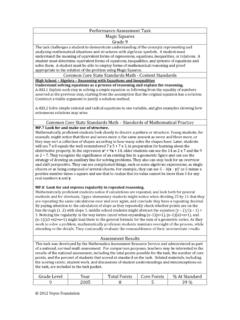Transcription of Are Humans Responsible for Global Warming?
1 Are Humans Responsible for Global warming ? A REVIEW OF THE FACTS. APRIL 2007. AUTHORS. James Wang, Bill Chameides, Are Humans Responsible for Global warming ? The case for attributing the recent Global warming to human activities rests on the following undisputed scientific facts: Carbon dioxide (CO2) is a greenhouse gas that warms the atmosphere. Since pre-industrial times, atmospheric CO2 concentrations have increased from about 280 parts per million (ppm) to over 380 ppm. Current concentrations of CO2 and other greenhouse gases are unprecedented in at least the last 650,000 years, based on records from gas bubbles trapped in polar ice. Independent measurements demonstrate that the increased CO2 in the atmosphere comes from burning fossil fuels and forests. The isotopic composition of carbon from these sources contains a unique fingerprint.. Since pre-industrial times, Global average temperatures have increased by about C, with about half of the warming occurring over the past few decades.
2 The only quantitative and internally consistent explanation for the recent Global warming includes the intensified greenhouse effect caused by the increase in CO2 and other greenhouse gases. The National Academy of Sciences the independent organization of the country's most renowned scientists established by Congress to advise the nation on scientific and technical issues has concluded: The scientific understanding of climate change is now sufficiently clear to justify nations taking prompt action.. Some argue that the recent Global warming is due to natural fluctuations and not to human activities. This argument and its fallacies are discussed below. Argument 1: CO2 is not coming from human activities CO2 has natural sources: volcanoes for example. All animals exhale it. How can human activities be affecting the concentration of CO2 on a Global scale?
3 The Facts Natural processes emit large quantities of CO2 into the atmosphere, but they also remove it at nearly identical rates. This balance maintained the concentration of CO2 at a stable level for thousands of years prior to the Industrial Revolution. In the case of Global warming , the question is: What is causing the increase in CO2 concentrations? The answer turns out to be incontrovertible. The isotopic composition of carbon in atmospheric CO2 provides a unique fingerprint that tells scientists that the lion's share of the additional CO2 accumulating in the atmosphere is from the burning of fossil fuels. Argument 2: No one really knows why the climate varies The Global climate has fluctuated considerably over the Earth's history, either for unknown reasons or because of internal variability in the climate system. We do not know enough about the climate system to attribute the present Global warming to any specific cause.
4 The Facts It is true that the Earth's climate has exhibited wide swings over geologic time due to natural processes. However, scientists have reasonable qualitative explanations for most of the significant variations in 2. climate over geologic time;1 they can be largely attributed to specific processes, not to unknown internal oscillations. Many of the major climatic changes can be traced to changes in the Earth's orbit around the sun (Hays et al. Science, 194, 1976, pg. 1121). Others can be linked to specific events (such as the impact of a comet or meteorite or the assembly or breakup of supercontinents) that led to large changes in the concentration of atmospheric greenhouse gases. For more recent times (the past millennium), scientists have been able to quantitatively attribute the major temperature fluctuations to changes in solar activity, volcanic eruptions, and human-produced greenhouse gases and particulate pollution.
5 These natural processes can not explain the current warming . Argument 3: The Medieval Warm Period disproves Global warming The current warming trend is analogous to the Medieval warming Period (MWP). Since the MWP. was obviously a natural event, the current warming is also likely caused by natural processes. The Facts The Medieval Warm Period (MWP) refers to a relatively warm period lasting from about the 10th to the 14th However, the initial evidence for the MWP was largely based on data3 gathered from Europe, and more recent analyses indicate that the MWP was not a Global phenomenon. A number of reconstructions of millennium-scale Global temperatures have indicated that the maximum globally averaged temperature during the MWP was not as extreme as present-day temperatures and that the warming was regional rather than Global . Perhaps the most well-known of these is that of Michael Mann and colleagues (Nature, 392, 1998, pg.)
6 779). Their reconstruction produced the so-called hockey stick graphic that contributed to this conclusion in the 2001 assessment of the Intergovernmental Panel on Climate Change: The 'Medieval Warm Period' appear(s) to have limited utility in describing trends in hemispheric or Global mean temperature changes in past centuries.". The accuracy of the hockey stick graphic was widely discussed in the press when the Mann et al. methodology was criticized by McIntyre and McKitrick (Geophys. Res. Lettr, 32, 2005, pg. L03710). Less attention was given to subsequent studies, such as that of Moberg and colleagues (Nature, 433, 2005, pg. 613) and Osborn and Briffa (Science, 311, 2006, pg. 841) that were based on different, independent methodologies but reached conclusions similar to Mann. Observations of melting high altitude glaciers are perhaps even more telling.
7 Andean glaciers that have been intact for more than 5,000 years are now rapidly melting (Thompson et al. Proc. Nat. Acad. Sci., 103, 2006, pg. 10536). If the MWP was truly Global , these glaciers would not have survived. More generally, it is a logical fallacy to argue that because the climate has changed in the past due to natural causes, the current warming trend must also be due to natural causes. The debate over the magnitude and causes of earlier climate change such as the MWP is of scientific interest, but it does not invalidate the considerable direct scientific evidence that human-produced greenhouse gases have been causing the Earth to warm recently. Argument 4: Recent predictions of a new ice age disprove Global warming In the 1970s climate scientists were saying an ice age was imminent. Now they say the Earth is warming . They don't know what they are talking about.
8 The Facts The Earth's climate for the past 2 million years has been characterized by ice ages lasting close to 100,000 years, punctuated by relatively short (10,000- to 30,000-year) warm periods or interglacials.. The swing from glacial to interglacial is caused by changes in the Earth's orbit around the sun amplified by natural feedbacks involving greenhouse gases (Hays et al. Science, 194, 1976, pg. 1121). The Earth entered the present interglacial about 10,000 years ago. All things being equal ( , in the absence of a large human-produced source of CO2) it is highly likely that the Earth will swing back into a glacial period or ice age. But this will not occur for thousands of years. 3. As early as the 19th century, scientists recognized that greenhouse gases warm the planet, and that increases in atmospheric carbon dioxide could lead to Global warming on time scales of decades to centuries much shorter than the fluctuations related to ice ages and interglacials.
9 Around the same time, Global temperatures began to increase and scientists became increasingly concerned that Humans were interfering with the climate. In the 1950s the upward trend in Global temperatures unexpectedly halted and temperatures declined somewhat. This led some scientists to become concerned about Global cooling and, in turn, to headlines in the popular press about an imminent ice age. What the skeptics fail to admit is that within the scientific literature as opposed to the popular press Global warming remained a serious concern. Many scientists of the time argued that whatever the cause of the cooling, natural or otherwise, it would be eventually overshadowed by the warming effect of carbon dioxide. In 1979, the National Academy of Sciences warned that a doubling of carbon dioxide would increase Global temperatures by to (Carbon Dioxide and Climate: A Scientific Assessment, NAS Press, 1979) and shortly thereafter a resumption of the upward trend in temperatures was detected.
10 Over the past quarter century, scientific research on Global climate change has intensified, and programs on an international scale have been organized. More and more data are included in computer models that are capable of recreating past trends and more precisely predicting future scenarios. We now know that the mid-20th century pause in Global warming was caused by pollution from burning coal, which produced tiny particles or aerosols that blocked the energy from the sun. As aerosol emissions were controlled but greenhouse gas pollution continued to increase, the cooling effect of the aerosols was overwhelmed by the greenhouse gases, and Global warming resumed. Argument 5: Scientists cannot prove current warming is not natural Climate scientists can not prove that the current warming is not due to natural processes and therefore can not claim with certainty that the warming is due to human interference.
















